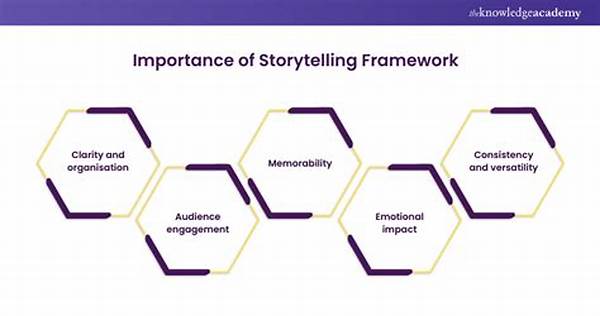Crafting narratives that captivate audiences, evoke emotions, and foster connections has always been at the heart of storytelling. In today’s digital age, however, the need to engage audiences in real-time and adapt stories accordingly has become pivotal. This is where audience-responsive storytelling frameworks come into play. They are not just about narrating tales but about weaving them interactively, considering the preferences, responses, and feedback of the listeners.
Understanding Audience-Responsive Storytelling Frameworks
Audience-responsive storytelling frameworks revolve around the idea of tailoring narratives to fit the dynamic nature of audience interactions. Imagine having the ability to gauge readers’ emotions and preferences instantaneously and tweak narratives to better suit their inclinations. This approach not only makes stories more engaging but also creates a two-way conversation between the storyteller and audience. By leveraging tools like data analytics and real-time feedback, storytellers can craft experiences that resonate on a deeper level. Whether it’s a brand story, a marketing campaign, or a personal tale, responsiveness to audience cues can significantly enhance the impact and reach of stories. This approach signifies a shift from one-way storytelling to a more interactive and adaptive narrative structure.
The Power of Audience-Centric Narratives
1. Audience-responsive storytelling frameworks allow for real-time adaptation, ensuring that narratives remain engaging and relevant.
2. By incorporating audience feedback, storytellers can create more personalized experiences.
3. This approach fosters a deeper emotional connection, as stories evolve in response to audience reactions.
4. Interactive storytelling elevates engagement, making audiences participants rather than mere spectators.
5. This dynamic method ensures that stories remain fresh and aligned with audience interests and feedback.
Integrating Data into Storytelling
The integration of data analytics is crucial for audience-responsive storytelling frameworks. Data provides insights into audience behavior, preferences, and trends. As storytellers gather this information, they gain the power to adapt narratives seamlessly. Imagine watching a series and having the plot shift based on viewer preferences—an audience-responsive approach that makes viewers feel directly involved in the story’s journey. This dynamic adaptation not only keeps audiences hooked but also offers a unique and personalized experience. By tapping into data, storytellers can cultivate narratives that are as much about the audience as the story itself.
Crafting Engaging Narratives with Real-Time Feedback
Audience-responsive storytelling frameworks have revolutionized how stories are crafted and shared. The ability to adapt narratives based on real-time feedback keeps stories fresh and engaging. This strategy is similar to a conversation where both parties respond to one another, creating a dynamic interplay of ideas and emotions. By capturing the pulse of the audience and incorporating their feedback, storytelling evolves into an art form that not only informs but also entertains and connects. This approach propels storytelling beyond traditional boundaries, allowing for creativity to flourish in ways previously unimaginable.
1. Empathy: Understand and anticipate audience needs to create impactful narratives.
2. Interaction: Encourage and incorporate audience participation for enriched storytelling.
3. Real-Time Adaptation: Modify stories based on immediate feedback to enhance engagement.
4. Personalization: Tailor experiences to individual preferences.
5. Continuous Learning: Evolve storytelling techniques by analyzing audience reactions regularly.
The Interactive Potential of Modern Storytelling
Audience-responsive storytelling frameworks are challenging the traditional narrative molds by inviting audiences into a more interactive space. This engagement transcends the typical storyteller-audience dynamic, creating a collaborative environment that celebrates creativity and spontaneity. The real challenge is to maintain the core message while staying flexible enough to adjust according to the audience’s reception. Storytellers must walk a fine line between guiding the narrative and allowing it to organically evolve. In this synergistic relationship, both storyteller and audience contribute to an ever-changing narrative tapestry. Such a collaborative approach fosters not only a shared creative journey but also a profound sense of collective ownership of the story being told.
Narratives as Evolving Communal Experiences
When storytelling becomes an evolving communal experience, stories gain life and vitality from those they touch. Audience-responsive storytelling frameworks are more than just a narrative technique—they are a cultural shift in how we create and consume stories. As stories adapt to the rhythm and nuances of their audience, they become a shared cultural fabric, weaving connections across diverse perspectives. This democratization of storytelling invites more voices into the narrative, enriching it with different angles and insights. Moreover, this collaborative experience opens up new pathways for empathy, understanding, and shared joy. Thus, storytelling becomes a powerful tool for not only conveying information but also for building community and fostering dialogue.
Conclusion: Embracing the Future of Narrative
In a world saturated with content, audience-responsive storytelling frameworks offer a refreshing approach that places the audience at the storytelling epicenter. By crafting narratives that are flexible and responsive to feedback, storytellers can cultivate stories that captivate, resonate, and linger in the minds and hearts of their audience. As this method becomes more mainstream, the potential for storytelling to effect change and foster connectivity on a global scale is immense. The future of storytelling is as much about listening as it is about telling. By embracing this future, we open ourselves to infinite narrative possibilities where every story becomes a shared journey, co-created by those who tell it and those who receive it.
